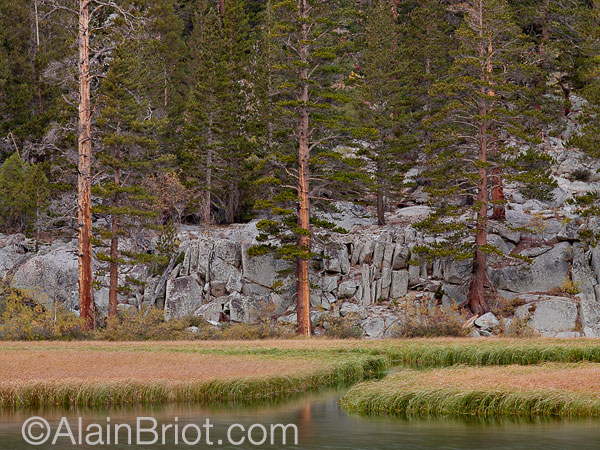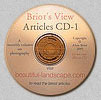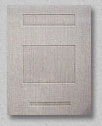
• Craft and Techniques - 50 •
Click here to see the other essays in this series
Interview with Luis Argerich
by Alain Briot
Introduction
Luis Argerich operates latinphotographia.com, a photography forum in Argentina . Luis was interested in doing an interview with me, but since I do not speak or write in Spanish fluently, going on Luis’ forum to answer questions was not an option.
To remedy this challenge, Luis and I decided to do an online interview over email. Luis asked forum members for their questions, then emailed these questions to me.
As a result I received a long list of questions on many aspects of photography. My first step was to divide the questions in two sections: artistic and technical, in order to reflect the dual emphasis that I place on Fine Art Photography.
Below is the list of questions sent to me by Luis. The name in parenthesis is the name of the person who asked each question:1- Technical Questions
Question 1: Do you need to use filters for landscape photography? If so which ones are the most needed filters? (juand)
Answer: With digital I hardly ever use filters since all filter effects can be done digitally, except for polarization. I therefore carry a polarizing filter but in practice I rarely use it.
Question 2: Can you comment your technique for panoramic photos. I'm interested in equipment, technique and software used for panoramic photos (jorgechi)
Answer: I actually simply take several photographs with the camera on my tripod with ballhead, making sure there is roughly a 30% overlap from one photo to the next. Afterwards I convert the photographs then stitch them in CS4 using Photomerge. All the collages on my site are done this way. Parallax has proven not to be a problem for me with this approach
Question 3: I'm interested in the difference you get in results for B&W when you use color filters in the lens with digital or film and in case there are any differences then what kind of parameters you need to correct when editing to achieve images similar to film. Always considering landscape photography. (dhr)
Answer: I don’t try to achieve digital photographs similar to film. I try to achieve photographs that are similar to my vision. Digital has a unique look that I want to keep. In my work, film images look like film images and digital images look like digital images.
Question 4: Do you need to use MF or LF for landscape photography? (djoso)
Answer: I do because I like working with MF and LF. However, this is a personal decision. You can certainly achieve excellent results with other formats.
Question 5: What kind of metering do you advise to use for landscapes and what do you meter? (djoso)
Answer: With digital I no longer meter the scene. I expose by histogram, meaning I make an educated guess about the exposure, take a photograph, look at the histogram, and make over or under exposure corrections depending on what the histogram looks like.
Question 6: Where do you meter to get a good sunset picture? (djoso)
Answer: See above. Exposure is no longer an issue with digital. All you need is a raw file that captures the detail you want to show in the print, as shown in the file’s histogram.
Question 7: How do you convert to B&W? Do you compose in colour and then convert or do you see something when editing that makes you decide to convert to B&W? (Fernando38)
Answer: Currently, I create few B&W images. When I do it is because color does not add interest to the image. In that case I convert the image to B&W in Photoshop by creating a “Black and White” adjustment layer.
 |
Three Trees, Eastern Sierra Nevada
2- Artistic Questions
Question 1: What is most important to you to get a great landscape photo? quality of equipment or the quality of light? (pagliardini)
Answer: Quality of light. Light is everything in photography. Photography means “writing with light” from the Greek photos, light and graphos, writing or drawing. There can be no good photographs without good light.
Question 2: Are there any major differences in composition technique between landscapes and traditional photography or just the same rules? (djoso)
Answer: What do you mean by “Traditional Photography?” Personally I think that landscapes are traditional photography !
Question 3: Can you give us some recommendations to get good landscapes? (djoso)
Answer: Study natural light and become the world’s expert in natural light. Then study composition with the goal of creating images that reflect the strongest way of seeing a specific scene.
Question 4: What do you seek in a landscape? In other words. What attracts you from a scene to photograph it and what do you want to get when photographing it, a representation of what you saw or your own version that is not always a representation of reality? (Patricio Murphy)
Answer: I am attracted to scenes that I find visually exciting. My goal is to express my emotional response to the scenes that I photograph. I am not interested in representing reality. In fact I find reality boring. I see reality everyday around me, and the last thing I want to do in represent reality in my art! I am interested in representing my personal vision of the places that I photograph and in making these representations believable rather than real.
Question: Do you or landscape photographers in general allow or accept digital manipulation such as changing a scene removing or adding elements? Is it ok to remove birds, objects, add clouds, etc? If allowed what is the limit? (Martin Bordagaray)
Answer: This is something that depends on each photographer. Personally I do everything I can to create images that represent my personal vision, including “manipulation” as you say.
Question 5: One problem I see with landscapes is how to create a landscape that is different to the other ones. How do you find that extra thing that is needed to get a unique view of a landscape? How do you avoid taking the same picture all other photographers can take? (Guido Medici)
Answer: I ask myself “what do I feel about this landscape?” when I photograph. I listen to my emotions and I take written and/or audio notes of how I see the scene in the field. My goal is to express these emotions visually in my prints once I am back in my studio.
I
do not try to duplicate the work of other photographers who came before me. I am not like them and I cannot see the world the way they do. My goal is not to re-do what they have done. My goal is to be faithful to myself and to my vision.
Question 6: How did you get started with photography and what took you to be a landscape photographer? What are your most important influences as a photographer? (Patricio Murphy)
Answer: I like the detail level, the direct relationship to the actual location, and the 21st century technology aspect of photographs. At the same time I like the minimization, the simplification and the visualization process that painting offers. My work is an attempt at combining all these elements.
Question 7: Did you start as a landscape photographer? If not what kind of photography made you famous? (melectro).
Answer: I started as a painter and an artist and I continue to be influenced by painters as well as by photographers. My work was shaped by seeing world-class paintings and world-class photographs early on in Paris and by studying painting. drawing and photography concurrently. These experiences influenced me and continue to influence me in powerful ways.
Question 8: What kind of factors help you decide if a landscape will be better in colour or B&W? (Thoso)
Answer: I look at whether color adds something to the image or not. Most of the time it does. When it doesn’t the image is usually rejected. Occasionally it is turned into a B&W photograph.
Alain Briot
Phoenix, Arizona, October 2009
Here is the spanish version of this interview on Luis Argerich's forum:
http://www.latinfotografia.com.ar/foros/index.php?topic=1504.new;topicseen#new
Essay and photographs Copyright © Alain Briot 2009
All rights reserved worldwide








